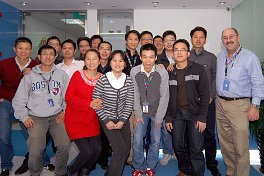Engineering Education in Exotic Places
I count myself as one of the lucky people for many reasons, but one of the top reasons is my work with Eogogics, Inc. I travel to some fairly exotic locales as an Eogogics faculty member, and I see parts of the world many folks do not. These sometimes include places closer to home (such as Puerto Rico, Mexico, and northern Canada – wow, it was cold up there!), and others not so close, such as Cartagena, Greece, Israel, Turkey, Bangkok, and most recently, Guangzhou. Guangzhou is in southern China, about two hours up the Pearl River from Hong Kong. It’s well off the tourist trail, and I loved it. Like many of my other Eogogics assignments, my time in Guangzhou was the adventure of a lifetime. My friends ask me what it’s like as an Eogogics instructor and I tell them “I am Indiana Jones with a passport and PowerPoint.”
Let me back up a bit. My teaching for Eogogics includes such subjects as systems engineering, process optimization, root cause failure analysis, failure modes and effects analysis, design of experiments, and engineering statistics. A couple of years ago, Eogogics sent me to teach a failure analysis course to a well-known high-tech company based in California (in my own backyard), and the class was such a hit that the client wanted us to go to Guangzhou to teach a series of RCFA classes for nearly 100 engineers in their China-based operations.
I knew this trip would be special, so I took my wife with me this time. We arrived in Guangzhou five days before the start of our training program. We wanted to explore. My work takes me well off the tourist trail, and this adventure promised more excitement than usual. Guangzhou is not part of the typical China vacation package, and I like that. I’m not interested in seeing what tourists see. I want to see what the people who live there see. I want to experience the area as it exists, not as a travel agency thinks I should see it. Our previous visit to China was 10 years ago, and at that time, the country was in an enormous growth spurt. I knew that China’s growth and development had continued, and my wife and I were eager to see the country today.
Images from Guangzhou showing (left) a view from the Canton Tower showing the Pearl River and downtown Guangzhou and (right) a prominent resident of the local zoo.
 |  |
Our stay in Guangzhou provided a proper window into modern China. Guangzhou is a city of more than 11 million people. It’s orderly and it’s spotless. Imagine a modern city with absolutely no trash, no litter, clean streets, and exceedingly polite people. We didn’t even see gum on the sidewalks. The place is immaculate. Language was not an issue; the Chinese study English starting in elementary school. We took it all in and enjoyed it enormously. We ate in traditional Chinese restaurants (cobra, anyone?), and on days when our tastes were more mundane, we ate at Kentucky Fried Chicken, McDonald’s, Pizza Hut, or Papa John’s.
We found significant advances since our last visit to China. On that earlier trip, bicycles dominated the morning and afternoon rush hour; imagine tens of thousands of commuters on bicycles…10 years ago, China was a land of pedal power! Today, automobiles predominate (there were very few bicycles), yet we saw no traffic jams and the air was clear. Somehow, the Chinese have found a way to keep the traffic moving and the skies clean. One contributor is that all of the taxis and buses in Guangzhou use liquid propane instead of gasoline or diesel fuel. Another is a massive public transportation system. Clean fuels, modern city planning, and a natural predisposition toward courteous behavior are working well here.
Guangzhou is China’s manufacturing hub. The greater Guangzhou region manufactures something on the order of $300 million of goods every day. It’s a phenomenal industrial center. Roughly one-third of all the manufactured goods in China are produced in this region. As a guy who’s spent a good chunk of his adult life in manufacturing, I felt like I was traveling to the Promised Land.
The Chinese took all of this a step further when they established Science City on the outskirts of Guangzhou. It’s all high tech, with buildings, architecture, and technology rivaling anything I’ve ever seen anywhere in the world. Imagine starting with a clean slate (a “green field,” as we say in the engineering world) and creating a brand new, high tech industrial village, and you’ll pretty much have Science City. The client put us up in a 5-star hotel right in the center of Science City, and the hotel staff worked very hard to be worthy of each of those five stars. It was awesome. Other than work and sleeping, though, we didn’t spend much time in Science City. For us, it was all about getting out and seeing Guangzhou.
It’s all high tech, with buildings, architecture, and technology rivaling anything I’ve ever seen anywhere in the world. Imagine starting with a clean slate (a “green field,” as we say in the engineering world) and creating a brand new, high tech industrial village, and you’ll pretty much have Science City. The client put us up in a 5-star hotel right in the center of Science City, and the hotel staff worked very hard to be worthy of each of those five stars. It was awesome. Other than work and sleeping, though, we didn’t spend much time in Science City. For us, it was all about getting out and seeing Guangzhou.
Guangzhou is not a tourist destination, but there’s a lot to see. I researched the city a bit before we left the US to visit China, and the hotel staff helped with maps and recommendations. We hit it all. Guangzhou has two world-class zoos, including one in the center of the city (we spent a day there, and I could have stayed longer). There are several magnificent Buddhist temples and pagodas. There are huge underground and pedestrian shopping malls. The Canton Tower is one of the tallest structures on the planet with an intriguing tram ride around the top (incidentally, the old name for Guangzhou is Canton). There’s a modern subway. There’s the Shamian district, kept intact from the British colonial days. The taxi drivers are great, the public transportation is efficient, and the people are fun. We stood out as US tourists, and because we were obviously enjoying ourselves so much, the folks in Guangzhou welcomed us even more. We found the Chinese people to be genuinely friendly and universally polite. Trust me on this: Guangzhou is a city worth seeing, and we saw it.
More images from Guangzhou showing (right) downtown Guangzhou’s Lotus Pagoda and (left) a Buddha statue inside the Lotus Pagoda.
 |  |
As I mentioned above, Hong Kong is only two hours down the Pearl River. We took a day, grabbed a train ride, and visited Hong Kong. That was fun, too. Great shopping, great sights, and more great restaurants!
The photos below capture some scenes of Hong Kong’s colorful streets.
 |  |
One thing we noticed (just as we had on our last trip) was overwhelming construction activity in every direction. Construction cranes dotted the horizon, with most of the construction involving huge apartment buildings. China is undergoing a mass migration, with much of the population leaving the countryside and moving into the cities.
was overwhelming construction activity in every direction. Construction cranes dotted the horizon, with most of the construction involving huge apartment buildings. China is undergoing a mass migration, with much of the population leaving the countryside and moving into the cities.
Turning back to the reason I traveled to Guangzhou, let me tell you about the training. Although everyone in class spoke English, the fluency levels varied and my hosts asked me to take this into account. Although I was apprehensive, I found this was a fairly easy thing to do. The comments at the end of the course indicated that the folks in my training sessions appreciated it. I found that the language barrier was no barrier at all.
All of my course participants were degreed engineers (they work in Quality Assurance, Supplier Engineering, Sustaining Engineering, Manufacturing Engineering, Design Engineering, and Software Engineering). These folks’ thirst for the specialized root cause failure analysis techniques was obvious, and the discussions were quite lively.
In addition to fault tree analysis and other sophisticated root cause identification tools, we covered several quantitative analysis techniques. The folks in China really latched on to these. It was rewarding and a bit scary. In some training sessions in the US, participants are less interested in statistics, design of experiments, and other quantitative topics. In the Chinese sessions, though, these topics elicited the greatest interest. The Guangzhou engineers grasped every nuance inherent to Taguchi testing, analysis of variance, operating characteristic curves, and other complex numerical topics that folks in the US often want to put behind them. I’ve never seen anything like it.
Class photos including one of James Chong, a class participant, and his son, Aaron.
 |  |

I like to tell a joke or two occasionally in my training sessions because it tends to keep the interest level high and, well, I like to tell jokes. When I’m training overseas, I’m always a bit hesitant to do that because jokes don’t always translate well. I asked my first group if I could try a joke, and they enthusiastically agreed to listen. When I finished, half the class laughed heartily. The other half was silent for just a few seconds (until someone translated the punch line). Then everyone was laughing. It was grand fun.
I’ll close with one more interesting observation. I’m a photography nut, and I never miss an opportunity on these grand adventures to grab great photos. I send them to my friends and family back in the US, and one morning when I connected my laptop to the overhead projector, folks in the first Guangzhou course saw some of my photos. They were intensely interested, so I made it a practice at the start of each day to show the previous day’s photos. I think my attempts to capture the beauty of my students’ homeland cemented my friendship with these fine engineers.
One of my students even called me at the hotel during my last weekend and volunteered to take me into the Chinese countryside so that I could photograph life outside the city. Rural China is rapidly disappearing, and it was a great opportunity. We spent a wonderful day with my new friend and his young son, and it was the high point of the trip for me.
Photos below capture scenes of rural China, including a market, the interior of a home, and a boy who loved posing for me.
 |  |
 |  |
 |  |
Teaching in exotic locales is a magnificent experience. I’ve made new friends, visited wonderful places, and had enormous fun. PowerPoint, my passport, and a plane ticket…it’s a tough combination to beat!
Editor’s Note: When not riding a motor scooter or snapping photos, Joe Berk teaches our engineering courses including Systems Engineering, Root Cause Analysis, Failure Modes/Effects, Industrial Statistics, Experiment Design, Quality Management, Cost Reduction, and Engineering Economics. Before joining Eogogics, he held senior management positions in quality assurance, operations, and marketing. He started his career with General Dynamics, where he led their F-16 Air Combat Fighter team in applying fault tree analysis to proactively identify potential aircraft accident causes. This led him to pioneer the application of fault trees as a failure analysis tool in the munitions industry, now widely adopted in that field. His subsequent work exposed him to the DoD, electronics, electro-optical, aerospace, automotive, biomedical, marine, ordnance, consumer goods, water treatment, metal fabrication, and other industries. His hands-on work in many engineering fields adds a real-world dimension to his classes that our clients appreciate. He has published nine books on systems management and continuous improvement as well as articles appearing in many well-known trade publications. Detailed bio


Sorry, comments for this entry are closed at this time.